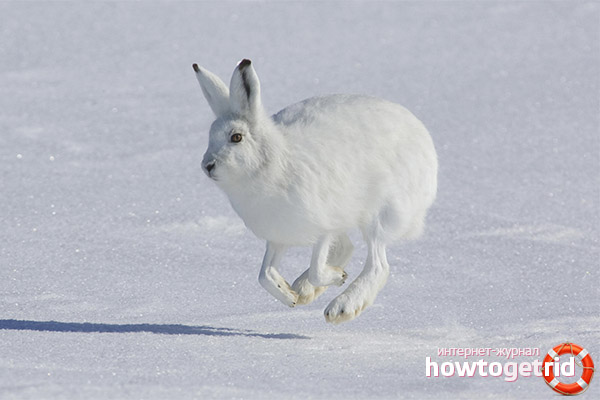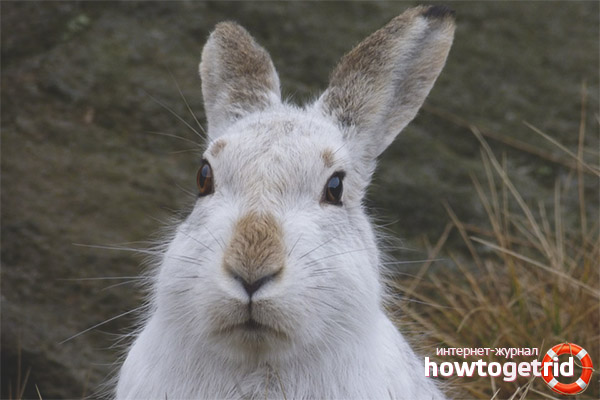The content of the article
- 1 Appearance of the hare subspecies
- 2 Daily hare behavior
- 3 Specifics of feeding hare
- 4 Breeding of the hare
- 5 Hare hare habitat
- 6 White hare population and factors influencing it
- 7 White hare protection
- 8 Hare and man
- 9 The influence of the hare on the ecological state of nature
- 10 Video: White hare (Lepus timidus)
Hare white hare from lat. Lepustimidus - an animal mammal, belongs to the order rabbit-like.
Appearance of the hare subspecies
This subspecies has paws large in width, completely covered with thick fur. The body weight of the animal can reach 4.5-5 kg. The length of the ears reaches 10 cm. A small rounded tail - about 6.5 cm.
The color of the hare changes with the changing season, the hair in summer is gray, sometimes with a shade of red. And in winter - snow-white, with barely noticeable dark spots on the ears. The hare sheds twice a year, this process depends on the temperature conditions in the habitat. In areas where snowfall is much less, the color of the animal remains grayish.
Daily hare behavior
With the abundance of necessary food supplies, the whitefish can overcome up to 9-10 km in one night, and in the opposite situation it can not master even three kilometers. An amazing fact: the hare has time to knock on the ground with its paws before retreating from its place. Thus, he gives his signal about the approach of danger. Entangling the tracks, the hare jumps five meters forward, and then sharply to the side.
Specifics of feeding hare
The animal belongs to herbivorous representatives. In the summer, food includes green plants, such as clover, leaves located on a habitable area.
In winter, finding food is much more difficult. During this period, the tree bark is used, birch or aspen, as well as branches of dry bushes, are suitable. Bumps found under the snow or dry grass provide food.
Breeding of the hare
Spring and summer are considered the most suitable for mating. Usually, up to seven cubs are born. In the season there are from two to four broods of offspring. The pregnancy period of the female hare hare lasts about 50 days. Bunnies are born with open eyes and can already move themselves. Oddly enough, the females feed not only their offspring, but also the cubs accidentally found, because the instinct encourages the rabbits to free themselves from excess milk from the accumulated milk in the glands.
When a person appears on the horizon, the female hare distracts him from her offspring, pretending to be wounded, trying to attract attention by tapping her feet on the ground. The male, however, does not take part in caring for the brood, but in turn does not interfere and does not cause trouble.
At the age of two weeks, rabbits begin to eat grass, stems and leaves of green plants on their own. The first eight days, the offspring feeds exclusively on mother’s milk, and then the kids switch to a normal diet. After reaching two and a half weeks, the babies become independent, and at the age of ten months they are ready for sexual activity.The life expectancy of hares is in most cases 17 years old.
Hare hare habitat

Like the hare, the habitats of this species are very diverse. Belyak is looking for life near the land where you can always find food, despite the season. Such a place may be the edges of mixed forests or bush thickets. Also, the hare lurks in tall grass, sometimes in reeds by the water - there it will be out of reach for enemies.
In the whale, the most developed sense organ is the rumor, which timely alerts him to the approach of a predator or any other misfortune. Vision and sense of smell are much weaker, and if a person stands nearby, even in an empty area, the whitefish can sometimes come quite close. In fact, the only safeguard against the pursuer is the ability to quickly run away. Interestingly, the haunted hare, only looking up a little from the pursuit, makes tricks. Hares over the course of evolution have learned to get away from predators with incredible dexterity, cunning and flawless disguise. The running speed can be compared by the speed of a traveling car, and this is 50-60 km / h. With all this, without slowing down, they can make sharp turns, forcing the enemy to slow down in order to re-make a clever trick.
White hare population and factors influencing it
The abundance of this type of hare is located in especially northern regions, forests of the north-west of Europe (Switzerland, Norway, Scandinavia), in North America, in part of Russia close to Europe, in the tundra zone, on Sakhalin.
Sworn enemies of hares are animals such as wolverine, marten, but mostly a fox. In the winter season, hare fall into the clutches of predators more often than in the summer. Large birds of prey attack them, such as white-tailed eagles. Although hares have a sufficient number of enemies, but all of them do not feed exclusively on hares, a possible reason for this phenomenon is that their numbers are not too large. It has been proven from the findings of their remains that most white hares die from attacks by predators and rarely live to old age.
In past centuries, hare was hunted extremely rarely, most often they were found by chance, as partridges were chased. People of the older generation did not eat hares because of religious beliefs, which attributed hare, bear and squirrel to "dirty" animals, their consumption was not welcomed. For the purpose of fur procurement, hares were also not popular.
In general, the number of white hare is affected by many phenomena that affect its population.
White hare protection
Nowadays, the hare is an important goal of sports hunting and the fur industry. It is obtained in large quantities for food and skin.
During the construction and construction of roads and motorways, as well as the reconstruction of other linear communications crossing the forest and adjacent territories, devices are provided with special passages for the safe movement of wild animals along them.
Hare and man
Usually hares live next to humans.
Sometimes the population of a species is rapidly decreasing as a result of various epidemics. And in fertile years, the number increases sharply. Bursts of such phenomena occur, as a rule, once every 12 years.
The permanent harm caused by the whitewash in the lands and on the farms is quite small, and does not have a special effect on the economic activity of people. But over time, cases of infection of people during hunting periods became more frequent, the carriers of which are white hare, these include tularemia.
The influence of the hare on the ecological state of nature
The hare is a simple subspecies that easily adapts to a person nearby. The population changes dozens or even hundreds of times over time. The main reason for the extinction of the number of goals is epizootics, which are a consequence of the "harvest" of these rabbits. The nature of this phenomenon in rare cases can be established. There were cases of numerous deaths of hares of this breed from parasites of worms, of which nematodes (roundworms), which usually live in lungs, are especially dangerous. Intestinal diseases are also frequent. In times of a high population of white hares, the number of predatory animals that hunt them is increasing: foxes, golden eagles, and owls.
Video: White hare (Lepus timidus)











Submit